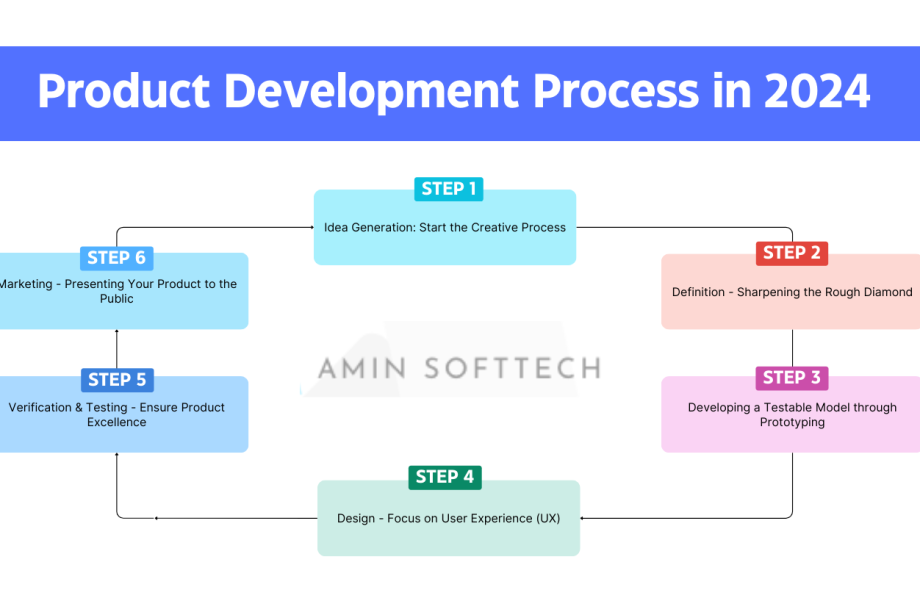The process of product development is always changing due to the growth of the global market, changing consumer demands, and technological advancements. In 2024, the traditional 6-stage product development process will remain a solid foundation. But in order to keep up with the times, you also need to implement new techniques and skills. Let’s discuss the fine points of each of the 6 stages in 2024:
Stage 1: Idea Generation: Start the Creative Process
- Thinking Outside the Box: When it comes to coming up with ideas,. To engage globally disparate teams and leverage the energy of various ideas, make use of online collaboration tools. Real-time digital innovative thinking and flowcharting are made possible by programs like Mural and Miro (formerly RealtimeBoard).
- Accept a User Requirements: User research transcends statistics in 2024. Conduct in-depth user interviews, gather user feedback through social media polls, and analyze app usage data to gain a deep understanding of user needs and pain points.
- AI-Powered Motivation: Explore the possibilities of AI tools such as software for product design that includes tools for market analysis and concept development support. You can find emerging market needs and come up with innovative solutions with the advice of these tools.
Stage 2: Definition – Refining the Diamond in the Rough
- Creating a Powerful Product Strategy: After collecting a range of possible concepts, formulate a different product view. All through the development process, this vision serves as a compass to make sure everyone is on the same page regarding the “why” behind the product.
- Consideration Based on User Value: Use consumer feedback and user research results to rank features according to their potential impact and user needs. Functionalities that offer the greatest value to users can be preferred with the help of methods like impact-effort matrices and user story planning.
Step 3: Developing a Testable Model through Prototyping
- Rapid Prototyping with Low-Fidelity Models: In 2024, rapid prototyping will be the standard. First, don’t waste time on complicated, high-fidelity prototypes. To rapidly test key features and get early user feedback, use low-fidelity mockups and prototypes created with programs like Figma or Adobe XD.
- VR Prototyping for Interactive Testing: Take into consideration the use of VR prototyping tools for specific product types. Consider utilizing a virtual reality prototype to test a product before it is properly developed! This has the ability to greatly enhance the final product’s user experience.
Stage 4: Design – Focus on User Experience (UX)
- Creating User Interfaces (UI) for All: Design that is inclusive is essential in the diverse world of today. All through the design process, conduct accessibility testing and apply better practices to make sure your user interface is accessible to users of different abilities.
- User Testing’s Power: Don’t stop at simple usability testing. To optimize user experience based on data-driven insights, run A/B tests on various UI elements and functionalities. Processes for A/B testing can be simplified with the use of tools like Of it or Google Optimize.
Step 5: Verification & Testing: Ensure Product Excellence
- Consider step of the process with Agile Methodology: Follow an agile development process that includes testing at every This makes it possible to find bugs early and make quick adjustments in response to user feedback.
- Start making the Most of Different Groups for Beta Testing: by using a different beta testing pool to test the product with a range of user types and demographics. This helps in finding potential bugs or functionality problems that a homogeneous testing group might forget.
Step 6: Marketing: Presenting Your Product to the Public
- Data-Driven Marketing: Create focused marketing campaigns by leveraging the data you’ve gathered during the development process. Customer relationship management (CRM) software and social media listening tools can be used for specific marketing campaigns.
- Creating a Strong Community: Don’t stop at product sales. By encouraging user involvement through online forums, social media groups, or exclusive beta tester programs, you can create a community around your product.
Conclusion: Beyond the 6 Stages
The 6-stage product development process acts as a roadmap, but in 2024, remember, it’s a continuous cycle. Data gathered post-launch should be fed back into the ideation stage, allowing for iterative improvements and product updates. Embrace the ever-evolving technology landscape, stay attuned to user needs, and be prepared to adapt—this is the key to success in the dynamic world of product development.

